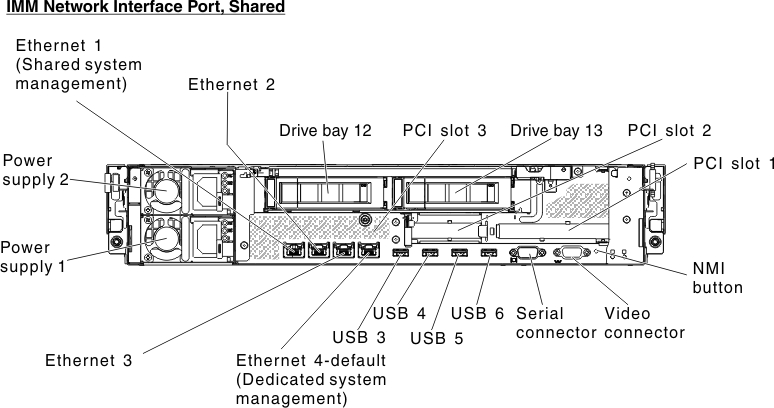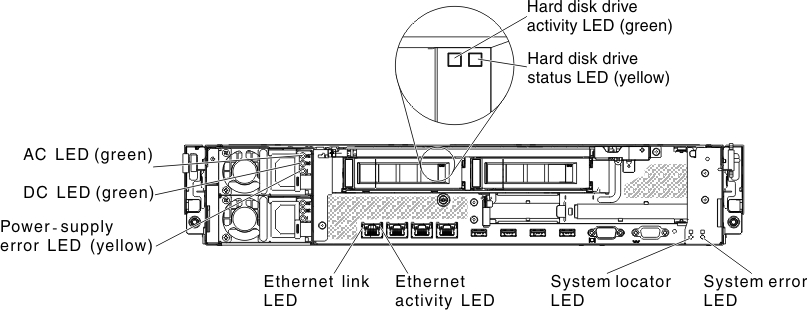Rear view
The following illustration shows the connectors on the rear of the server.
Figure 1. IMM network interface port


- Systems-management Ethernet connector:Use this connector to connect the server to a network for full systems-management information control. This connector is used only by the integrated management module (IMM2). A dedicated management network provides additional security by physically separating the management network traffic from the production network. You can use the Setup utility to configure the server to use a dedicated systems management network or a shared network.
- Ethernet connectors:Use either of these connectors to connect the server to a network. When you enable shared Ethernet for IMM2 in the Setup utility, you can access the IMM2 using either the Ethernet 1 or the system-management Ethernet (default - Ethernet 4) connector. See Using the Setup utility for more information.
- PCI slot connectors:
- PCI slot 1: Insert a full-height, half-length PCI Express* adapter into this slot.
- PCI slot 2: Insert a low-profile PCI Express* adapter into this slot.
- PCI slot 3: Insert a low-profile PCI Express* adapter into this slot.
- Power-cord connector: Connect the power cord to this connector.
- USB connectors: Each power supply has a dc power LED and an ac power LED. When the dc power LED is lit, it indicates that the power supply is supplying adequate dc power to the system. During normal operation, both the ac and dc power LEDs are lit. For any other combination of LEDs, see Power-supply LEDs.
- NMI button: Press this button to force a nonmaskable interrupt to the microprocessor. It allows you to blue screen the server and take a memory dump (use this button only when directed by the service support). You might have to use a pen or the end of a straightened paper clip to press the button.
- Serial connector: Connect a 9-pin serial device to this connector. The serial port is shared with the integrated management module II (IMM2). The IMM2 can take control of the shared serial port to perform text console redirection and to redirect serial traffic.
- Video connector: Connect a monitor to this connector.NoteThe maximum video resolution is 1600 x 1200 at 75 Hz.
The following illustration shows the LEDs on the rear of the server.
Figure 2. LEDs rear view
- Ethernet activity LEDs: When these LEDs are lit, they indicate that the server is transmitting to or receiving signals from the Ethernet LAN that is connected to the Ethernet port.
- Ethernet link LEDs: When these LEDs are lit, they indicate that there is an active link connection on the 10BASE-T, 100BASE-TX, or 1000BASE-TX interface for the Ethernet port.
- AC power LED: Each hot-swap power supply has an AC power LED and a DC power LED. When the AC power LED is lit, it indicates that sufficient power is coming into the power supply through the power cord. During typical operation, both the AC and DC power LEDs are lit. For any other combination of LEDs, see Power-supply LEDs.
- DC power LED: Each hot-swap power supply has a DC power LED and an AC power LED. When the DC power LED is lit, it indicates that the power supply is supplying adequate DC power to the system. During typical operation, both the AC and DC power LEDs are lit. For any other combination of LEDs, see Power-supply LEDs.
- Power-supply error LED: When the power-supply error LED is lit, it indicates that the power supply has failed.
- System-locator LED: Use this LED to visually locate the server among other servers. You can use Systems Director or IMM2 web interface to light this LED remotely.
- System-error LED: When this LED is lit, it indicates that a system error has occurred. An LED on the light path diagnostics panel is also lit to help isolate the error.
Give documentation feedback